Looking for a comprehensive Hubstaff vs Time Doctor comparison?
Tracking how your team spends their time with effective productivity tracking should make work easier and improve team productivity, yet it often has the opposite effect.
Reports can look complete, yet even detailed productivity reports can make it hard to see where the hours go or why projects slow down.
Whether your team is in the office, working in remote work settings, or somewhere in between, you want visibility that brings clarity and not control.
As Harvard Business Review notes, “By the end of 2025, 36.2 million Americans, or 14% of the U.S. adult population, are expected to work from home.”
And with more remote workers joining distributed teams every year, that trend makes your choice even more critical.
That is why understanding the difference between Hubstaff and Time Doctor matters.
Both provide insight into how you track employee time and manage productivity, yet they approach functionality and accountability in different ways.
In this article, you will learn how each platform supports focus, transparency, and better decision-making, so you can choose the one that fits your team best.
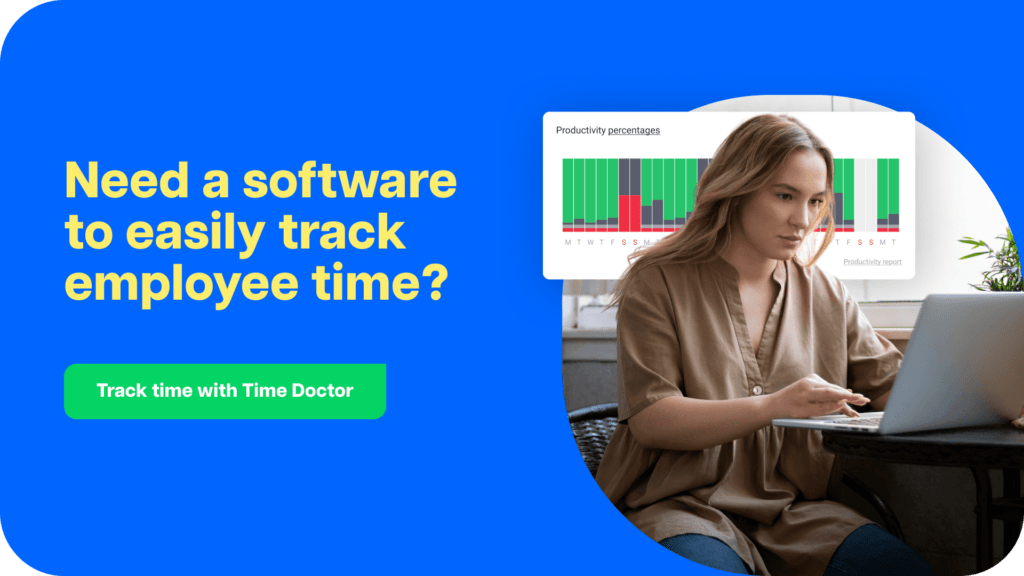
What we’ll cover
Let’s dive in.
What is Hubstaff?
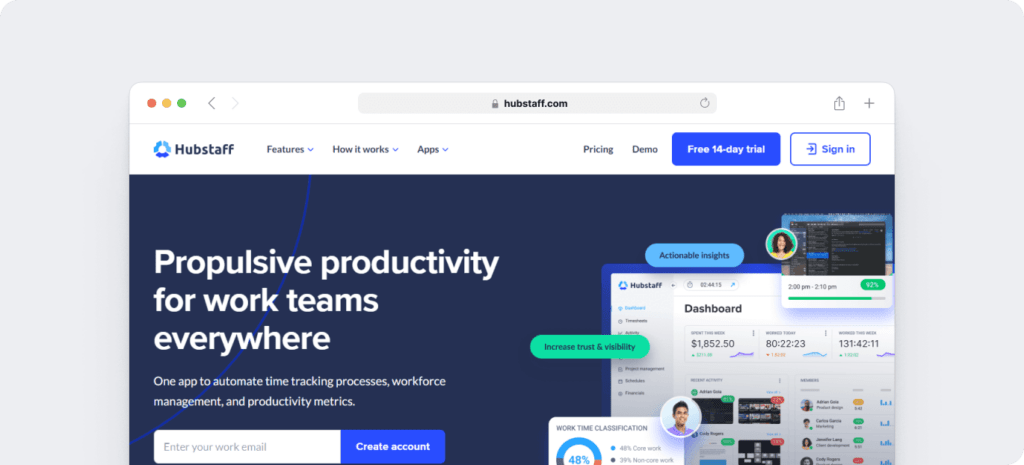
What is Hubstaff?
Hubstaff is a time tracking software and workforce management app that helps teams record work hours, manage schedules, and stay organized.
Hubstaff’s time tracking and task management features allow teams to log time on projects and tasks during work hours, with options that can be configured by your organization.
With Hubstaff, you can:
- Track time and view activity reports that show how work hours are spent..
- Capture optional screenshots to provide context on work activity.
- Automate payroll and create client invoices using tracked hours.
- Generate detailed reports and digital timesheets for projects and teams.
- Connect with project management, accounting, and payments, including asana, jira, trello, quickbooks online, and payroll providers such as paypal, wise, gusto, payoneer, and deel.
What is Time Doctor?
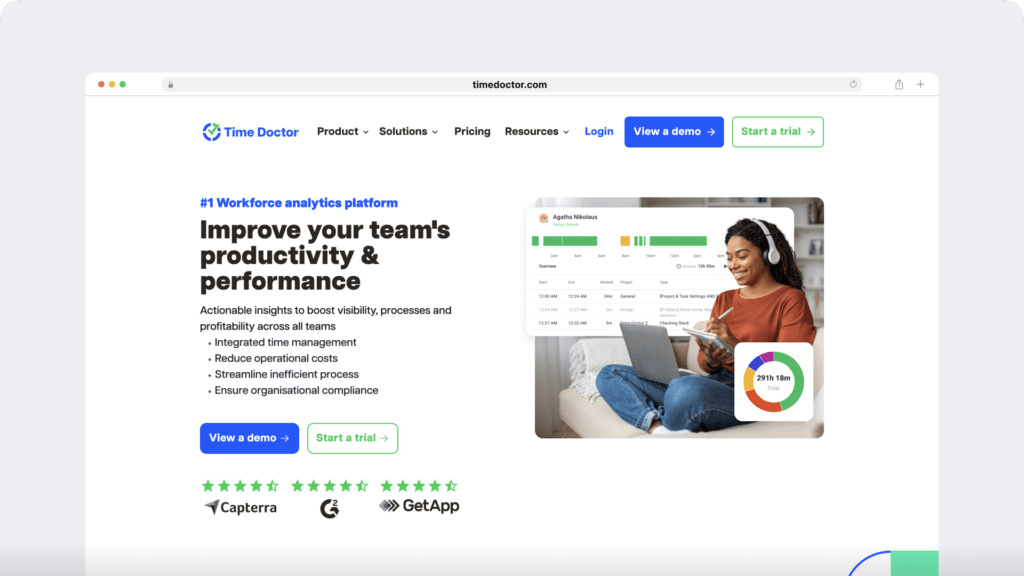
Time Doctor is a workforce analytics platform that turns work signals into clear, actionable visibility so you can lead with trust, coach with data, and keep remote, hybrid, and in-office teams on track.
When your policy calls for extra context, you can enable employee monitoring options such as screenshots, short screen recordings, and web and app usage with role-based access and blur for privacy.
Time Doctor offers managers the visibility to lead with trust, not control, enabling them to make informed decisions, support their teams, and optimize consistent performance across remote, hybrid, and in-office teams.
Time Doctor scales easily for organizations of any size, from large enterprises to small businesses and freelancers, making it simple to understand how work really happens across projects and teams.
With Time Doctor, you can:
- Track time spent on tasks and projects with precision.
- Generate insightful reports that highlight trends, bottlenecks, and opportunities to improve focus and performance.
- Review website and app usage data to see how work hours are allocated.
- Automate payroll and client billing based on verified hours worked.
- Integrates with project management software like Jira, Basecamp, Zoho Projects, Trello, and Asana for unified visibility across workflows.
Hubstaff vs Time Doctor comparison
Hubstaff vs Time Doctor: In-depth feature comparison
Here’s a feature by feature comparison to help you decide which tool — Time Doctor or Hubstaff — offers the best value for money.
Let’s look at what each of these tools has to offer:
1. Time tracking and activity accuracy
Here’s how both time tracking tools — Hubstaff and Time Doctor — record and manage time spent on tasks or projectsHubstaff approach
Hubstaff approach
A. Tracking time and viewing dashboards
With Hubstaff’s consistent user interface across desktop, mobile app, and Chrome extension, your team can record work hours easily and stay synchronized.
You can assign time to projects and tasks, then review timesheets to keep time management consistent across remote teams and in-office staff. After you sign in, your dashboard lets you:
- See total hours for the day and week
- Review weekly activity levels based on input data
- Check who on your team is online
- View time recorded by project or task
- Open and approve timesheets for accuracy
This gives you quick visibility into attendance tracking and how time is distributed across your workflow, supporting smarter team management.o attendance tracking and how time is distributed across your workflow, supporting smarter team management.
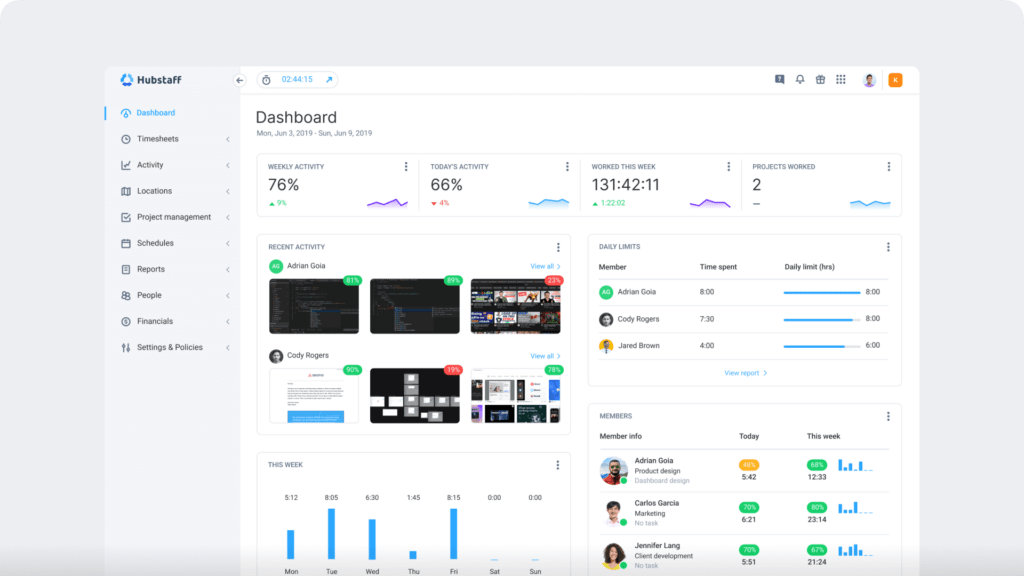
B. Activity levels
Hubstaff’s tracking features calculate an activity percentage from keyboard and mouse movements measured in 10-minute intervals.
You control how idle time is handled and how it appears in reports.
- Active input is counted as active time in the activity percentage.
- Periods without input are treated as idle or low activity.
- You can keep, discard, or prompt users about idle time, then filter or remove it in timesheets and reports
- Activity is intended to reflect engagement, not output or overall performance
These capabilities support managing remote employees, improve workflow visibility, and provide consistent activity and time metrics without manual reporting.
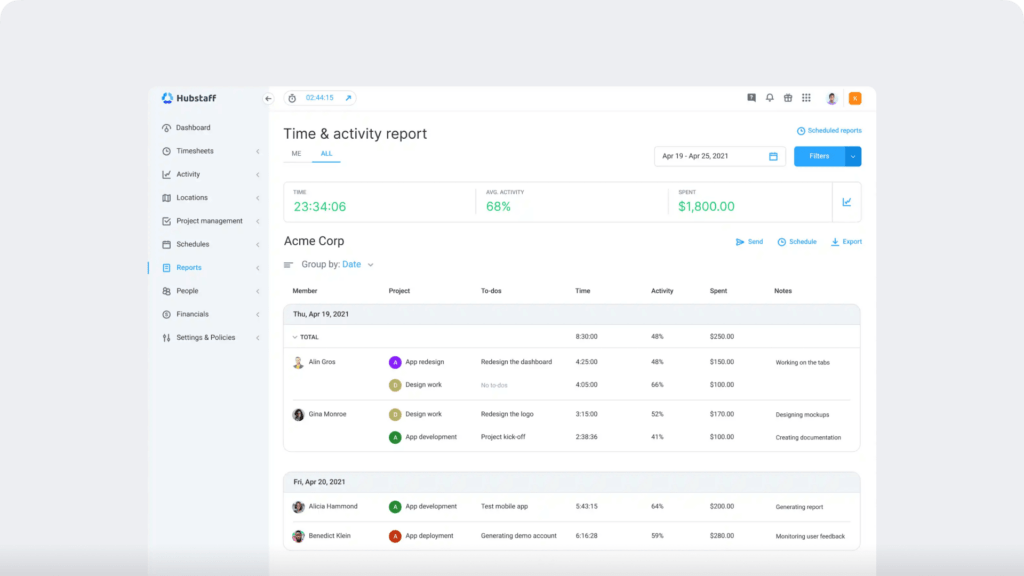
C. Offline and manual time options
Hubstaff supports manual entries and offline continuity, allowing you to control settings through permissions and approvals.
- Track time on the desktop app when the internet is unavailable and upload the data once the connection returns.
- Allow manual time entry for selected roles by enabling the Modify time setting and capturing a reason for each addition or edit.
- Require review and approval of manual time before it is added to the payable timesheets.
- Assign manual entries to the correct project or task and include notes from both desktop and mobile devices to ensure records remain clear.
Time Doctor approach
A. Interactive time tracking
With Time Doctor, you guide your team to track work hours in real time using the desktop app, mobile app, or Chrome extension. Time links to projects and tasks, so every entry has context for reviewable timesheets.
- Start or stop a task timer to record work as it happens
- Switch tasks to keep entries precise and tied to deliverables
- Assign task lists for your team or approve from an approved catalog
- View daily and weekly totals that roll into timesheets for approval
- See a timeline of work periods and breaks to spot gaps or overlaps
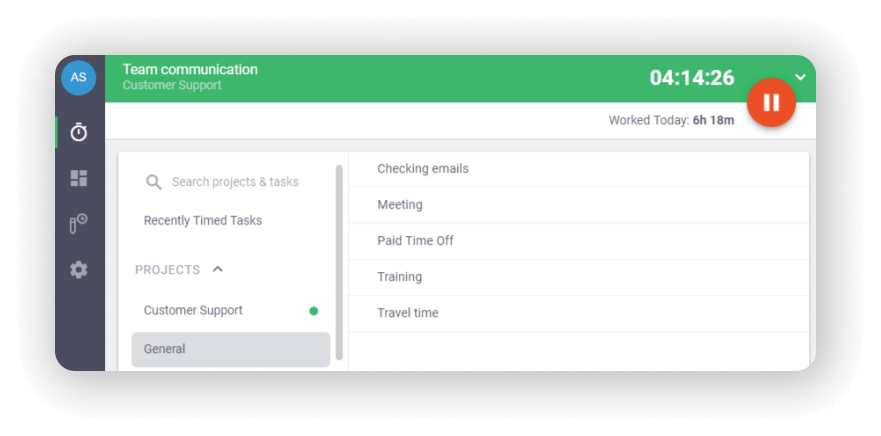
B. Idle time and activity signals
Time Doctor measures employee activity by interpreting keyboard and mouse input as signals, distinguishing between active minutes and idle minutes. You set the idle-time threshold that fits your workflow.
When there is no input beyond that limit, a prompt asks if the person is still working. If they are away, tracking can pause, and time can be marked as a break.
- Configurable idle-time prompts when no input is detected
- Option to pause tracking automatically after prolonged inactivity
- Activity percentages and timeline views that distinguish active time from idle time
- Website and app usage context to help you interpret activity alongside the tools being used
- Admin permissions to review and adjust entries so timesheets stay consistent for payroll and reporting
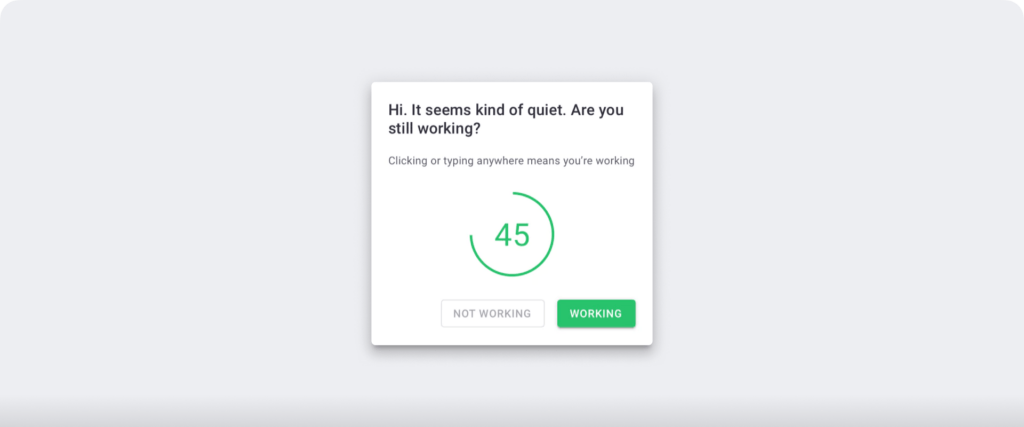
C. Offline and manual time options
Time Doctor supports work that happens without a stable connection and work that needs post-entry.
You control these options with permissions and approvals.
- Record time when the internet is unavailable and sync once the connection returns
- Allow selected roles to add time after the fact with a required reason
- Review, approve, or reject manual or offline entries before they post to timesheets
- Label manual and offline-synced entries for audit clarity and clean records
This design provides actionable visibility to lead with trust, transforming automatic time tracking data and activity insights into clear signals you can use across remote, hybrid, and in-office teams.

2. Employee monitoring and visibility
Clear visibility and ease of use help you support your team without micromanaging.
Both Time Doctor and Hubstaff offer user-friendly, configurable employee monitoring features with privacy controls and clear reports, allowing you to understand work patterns, coach effectively, and maintain a positive work environment.
Hubstaff approach
A. Screenshots
The screenshots feature adds visual context to activity monitoring, providing a clearer understanding of work patterns.
- Hubstaff can take randomized screenshots of a user’s screen within each 10-minute interval.
- You can set the capture frequency to 1, 2, or 3 screenshots per 10 minutes, or turn screenshots off for specific users or teams.
- If your policy requires more frequent captures, a More Screenshots add-on is available.
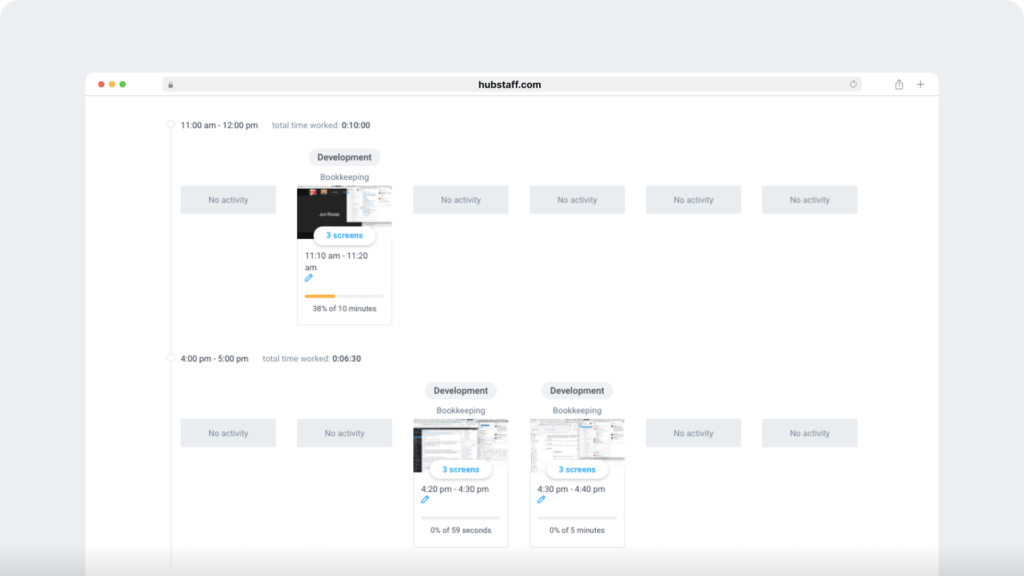
B. Web and app tracking
If enabled, Hubstaff records websites and applications used while the timer is running and shows this usage in reports.
- Apps & URLs reports list the sites and apps a user accessed during tracked time, along with time and percentages.
- The feature is managed at the organization level and only records data after it is enabled.
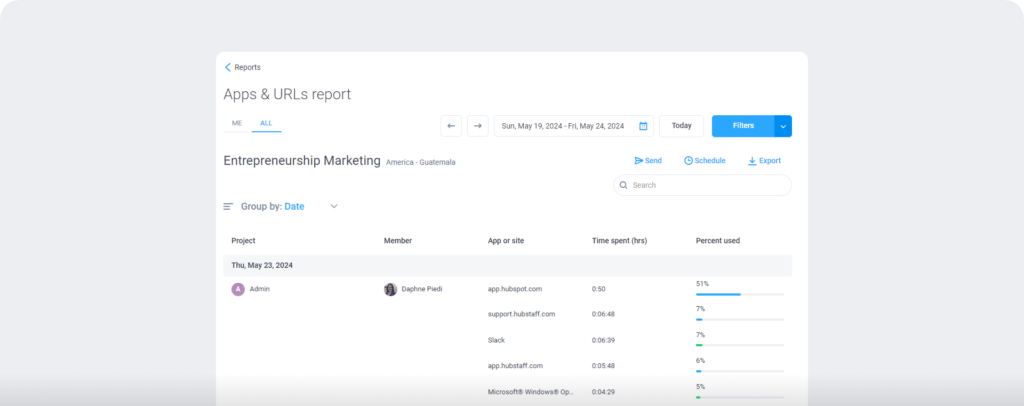
Time Doctor approach
A. Screenshots and screen recording
You want visual context without crossing privacy lines. With Time Doctor, you turn these controls on only when they support your policy, and you decide who can see them.
Screenshots and recordings capture activity only during tracked time, so breaks and off-time stay private.
- You can enable screenshots during tracked time and set the frequency at which they are captured to verify productivity levels and task focus.
- When you need richer context, you can turn on short screen recordings during tracked time and choose which teams are allowed to use them.
- To protect sensitive information, you can apply blur to screenshots and recordings at the company, team, or user level.
- If a team member deletes a screenshot or recording, the related time is removed from their timesheet, which keeps your records consistent.
- Because access control matters, you can use roles and permissions to decide who can view, review, or export visual records.
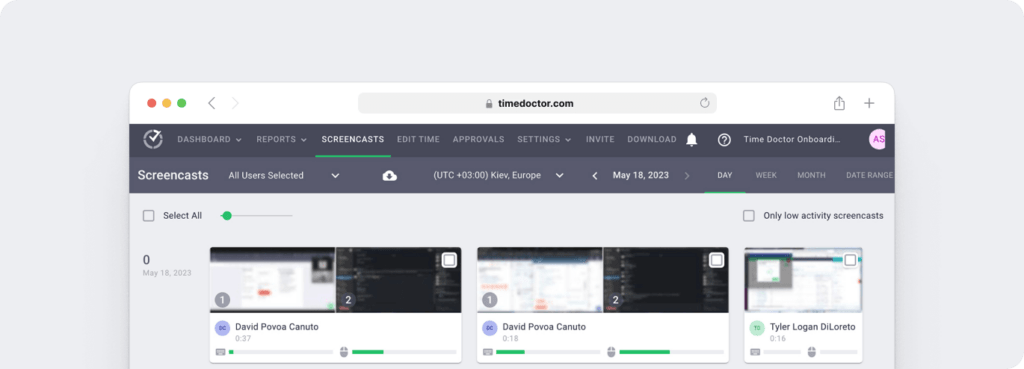
You need a clear view of which tools shape focus throughout the day. Time Doctor gives you a unified Web & App Usage view that summarizes where time goes during tracked sessions, so you can quickly spot patterns and coach with confidence.
- You see websites and applications used during tracked time, with totals and percentages that are simple to scan.
- You filter by person, team, project, or date range to focus reviews on the work that matters most.
- You choose how much detail to capture, from site and app names to full-page titles, so reporting fits your privacy policy.
- You pair this context with timelines and activity signals to turn data into actionable decisions, set clear expectations, and maintain positive accountability.
Taken together, these controls provide visibility without micromanagement, so you gain actionable context and lead with trust across remote, hybrid, and in-office teams..
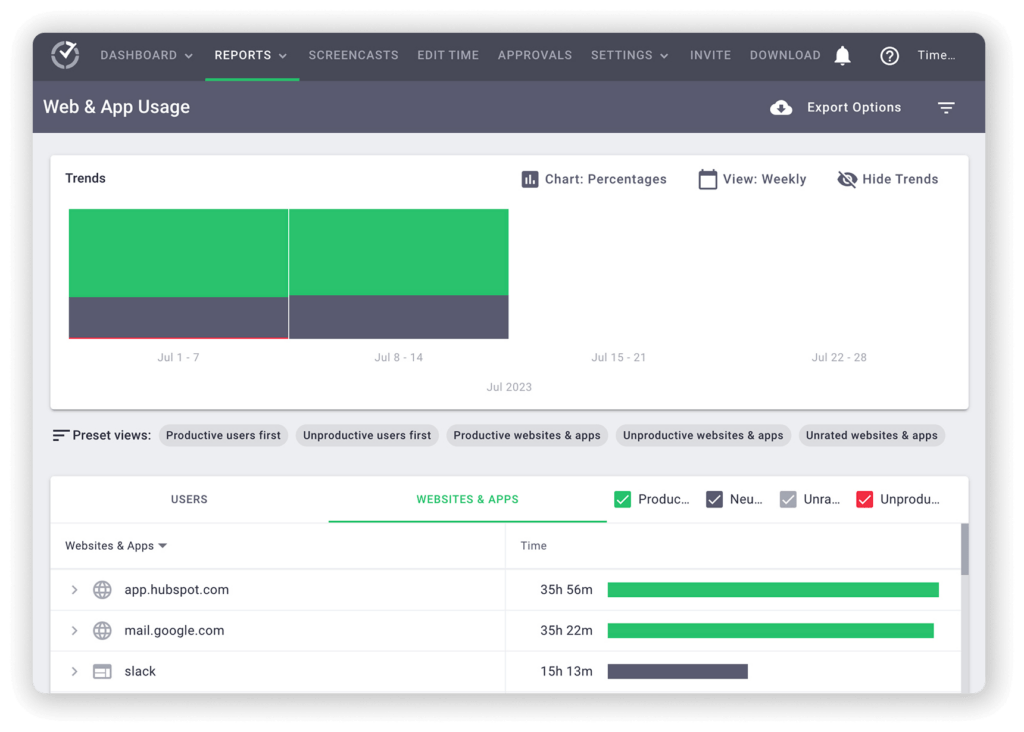
3. Productivity and distraction management
Staying focused is challenging when messages, alerts, and quick checks accumulate throughout the day.
This section looks at how each tool supports gentle prompts, clear context, and data you can use for coaching and better outcomes.
Hubstaff approach
With Hubstaff, you address distractions through visibility and prompts rather than on-screen nudges.
You can review Apps & URLs reports to see which websites and applications were used during tracked time, and you can enable inactivity warnings that ask team members whether to keep or discard idle time.
These settings help you spot patterns and start coaching conversations without micromanaging.
Time Doctor approach
You want a light touch that protects focus, not a blocker. Time Doctor turns activity signals into timely prompts and clear context so you can coach without micromanagement.
- When idle time passes your threshold, the app prompts the person or pauses tracking to keep timesheets clean.
- Timelines, activity levels, and web and app usage reveal drift early so that you can rebalance workloads quickly.
- Clear analytics turn patterns into next steps and support remote and hybrid teams with confidence.
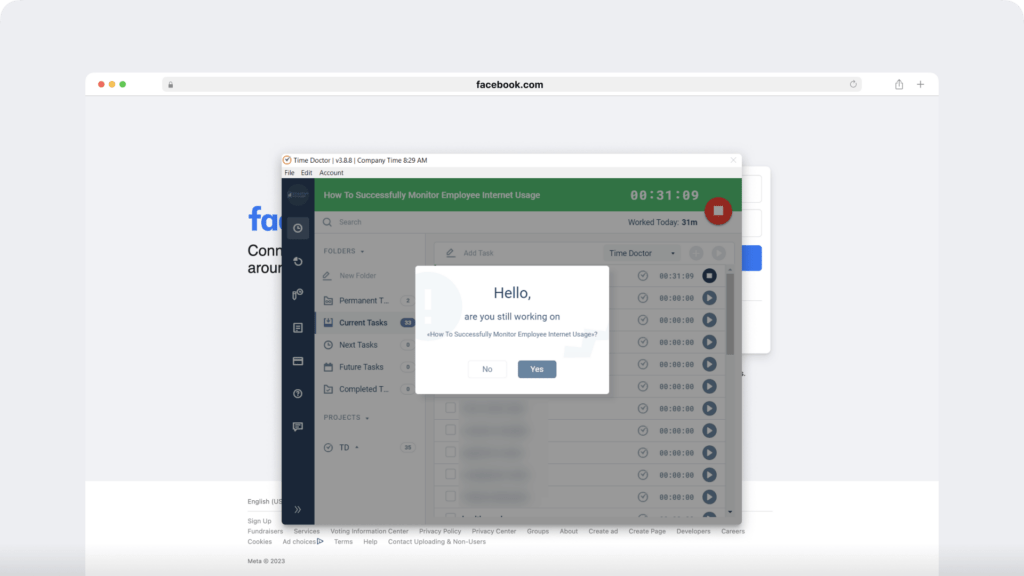
4. Employee privacy
Employee privacy comes first. With clear policies, transparent controls, and role-based access, you can protect personal data while still getting the visibility you need.
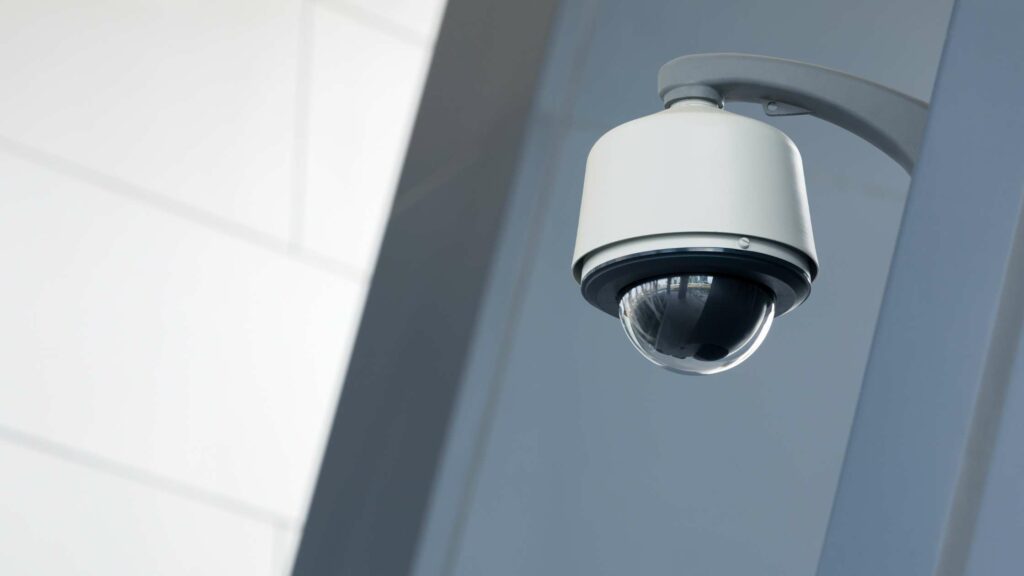
Hubstaff approach
Hubstaff detects keyboard and mouse input and records whether activity occurred each second; it does not log individual keystrokes or exact mouse actions. Activity is then summarized in 10-minute blocks.
Screenshots are optional and, when enabled, are captured during tracked time at a configurable frequency of up to 1, 2, or 3 images per 10 minutes; you can also turn them off per user or team.
Time Doctor approach
Time Doctor focuses on activity signals, such as keyboard and mouse presence, to indicate active time, and it does not record the actual keys you press.
Additionally, you can enable optional screenshots and short screen recordings during tracked time, and then apply privacy controls, such as company-level blur and role-based access, ensuring reviews remain purposeful and respectful.
From there, you decide who can view, review, or export visual records and manage access in line with GDPR/SOC 2–aligned practices, ensuring your monitoring policies are clear and consistent.
5. Reports and timesheets
With clear productivity monitoring reports, you can see patterns, spot bottlenecks early, and coach your team with confidence.
Both Hubstaff and Time Doctor include built-in dashboards and exportable reports, so you can move beyond manual spreadsheets and focus on what the data is telling you.
Hubstaff approach
Hubstaff includes a dedicated reports section with categories that help you review time, activity levels, usage, budgets, and payroll details.
The reports are divided into six categories:
1. General reports
Under general reports, you can generate:
- Weekly report – daily/weekly totals, activity percentages, and spent amounts.
- Manual time edits – a summary of additions, edits, or deletions to timesheets.
- Expenses – expense data by date and time, with billable filters.
- Timesheet approvals – view and manage timesheets pending approval inside the approvals workflow.
- Apps & URLs – websites and applications used during tracked time, with totals and percentages.
- Time & Activity – total time, activity, and pay/bill amounts by user, project, or task.

2. Payment reports
Two key payment reports help you manage payouts:
- Amounts owed – time marked as unpaid within the organization.
- Payments – a list of payments you’ve created or processed.
3. Budgets and limits
Budget tools surface spend and remaining capacity:
- Weekly limits – weekly caps per team member plus time worked and remaining time.
- Project budgets – a budget allocated per project, detailing the time spent and the remaining budget.
- Client budgets – budgets across projects linked to a client and time spent.
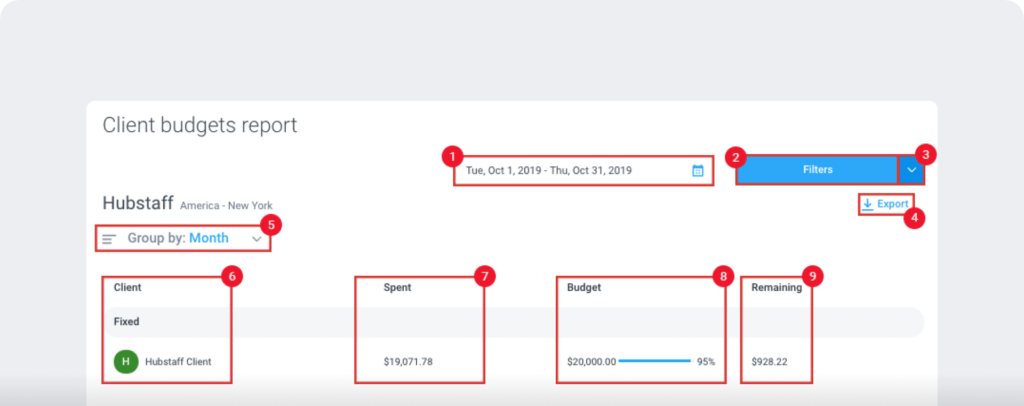
4. Time-off reports
Time-off reporting includes:
- Time-off balances – available, used, and pending balances.
- Time-off transactions – requests, approvals, and dates associated with time off.
5. Attendance report
- Shift attendance helps you review schedules and attendance from the Schedule/Reports area
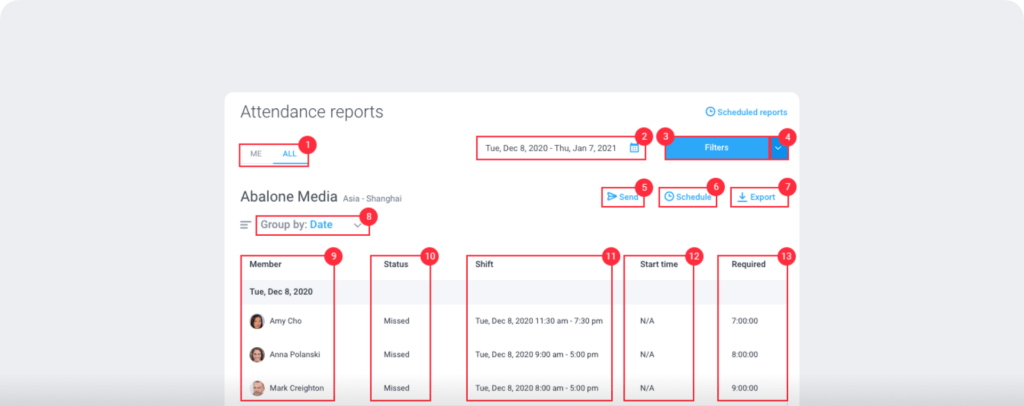
6. Job sites report
- Job Sites – Visits show when each team member entered or exited a configured job site. Availability requires Enterprise or the Location add-on
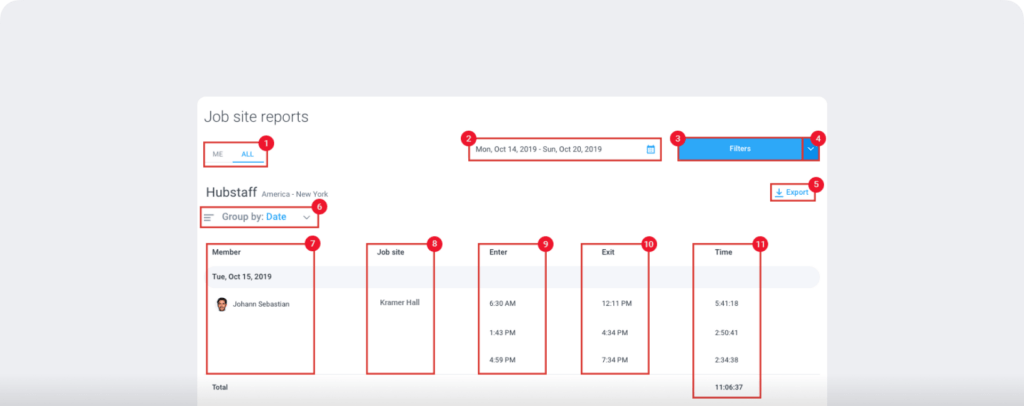
Hubstaff allows you to send reports by email, download them as a PDF or CSV file, and review geofencing data to see which team members worked on specific job sites and for how long.
Time Doctor approach
Time Doctor time tracker provides clear, built-in reports that turn time and activity data into actionable visibility for remote, hybrid, and in-office teams.
1. Dashboard
See who’s working now, total hours for the day or week, and a timeline of work periods. Hover to view task context and quickly understand how work is unfolding.
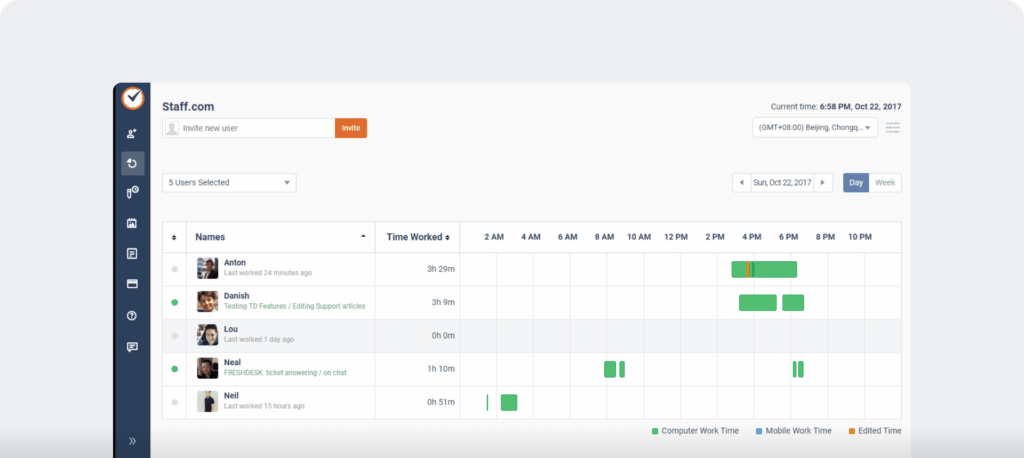
2. Timesheet report
Review accountable time by person for a day or week, then approve or request edits to keep timesheets consistent for payroll and billing.
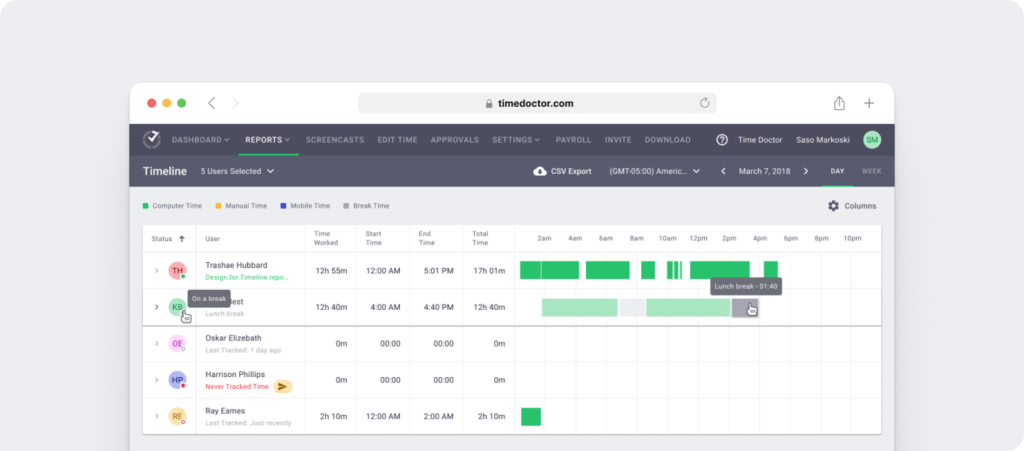
3. Time use report
Compare total hours across people and tasks to see where effort goes. Use it to balance workloads and support employee productivity coaching.
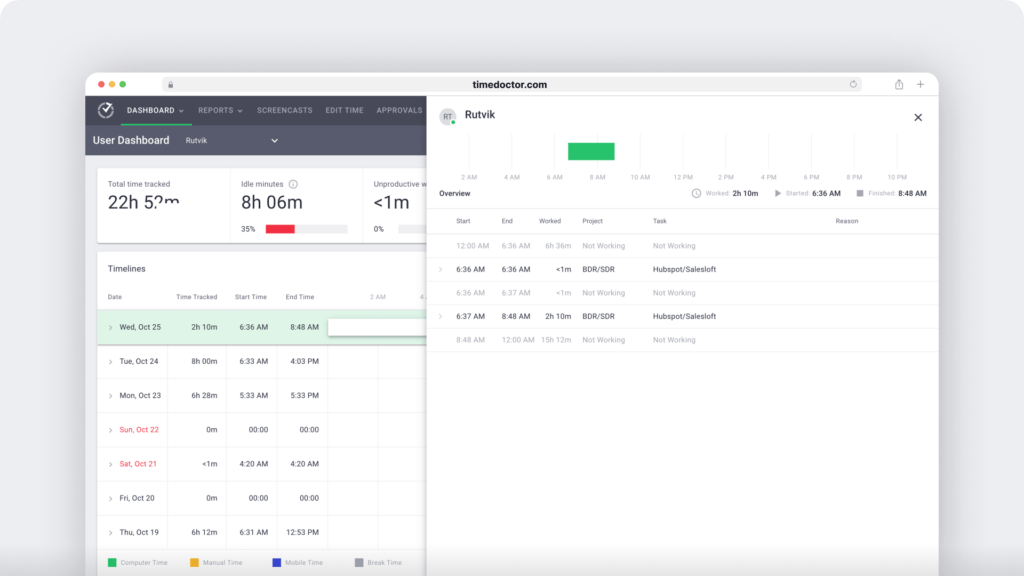
4. Timeline report
View a day’s activity by user, including work periods, breaks, and activity levels, so you can spot gaps, overlaps, or bottlenecks at a glance.
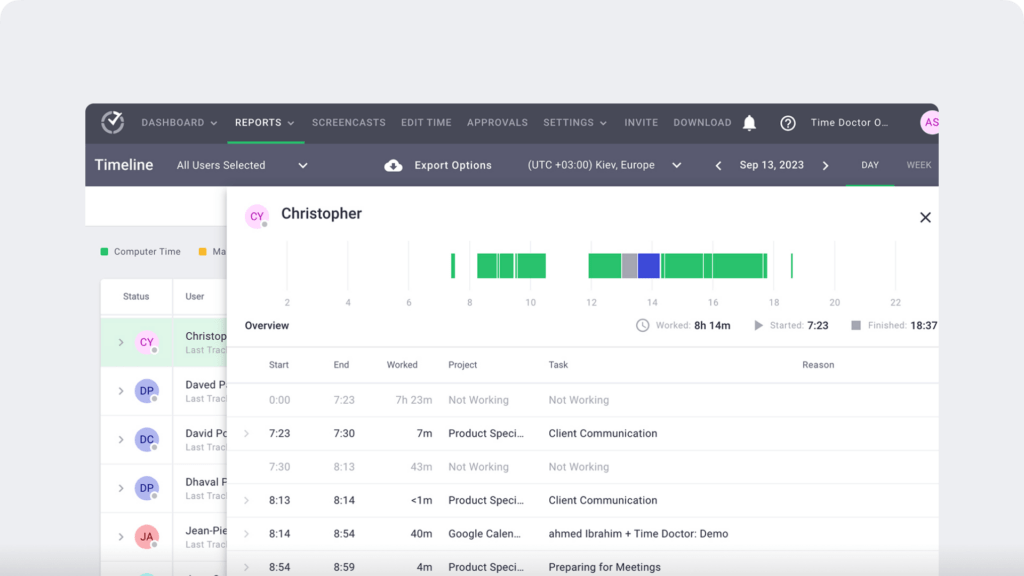
5. Poor time use report
Identify time spent on non-work sites or low-value activities during tracked hours. Use this for constructive 1:1s and distraction management, not punishment.
6. Web and app use report
See which websites and applications are used during tracked time, with totals and percentages. Filter by person, team, project, or date to find patterns.
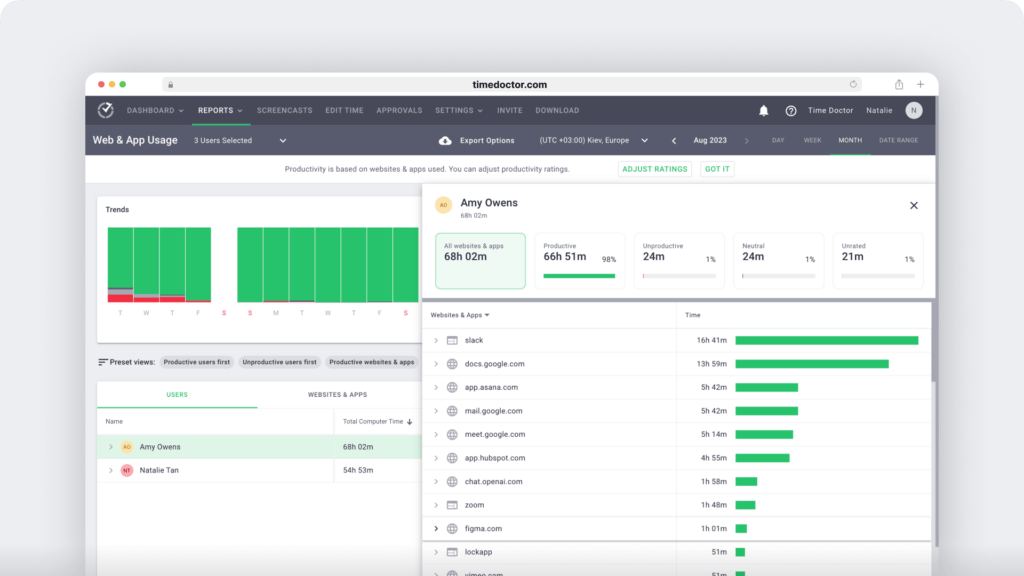
7. Projects report
Track hours by project and contributor to understand scope, costs, and allocation. This supports project management and better capacity planning.
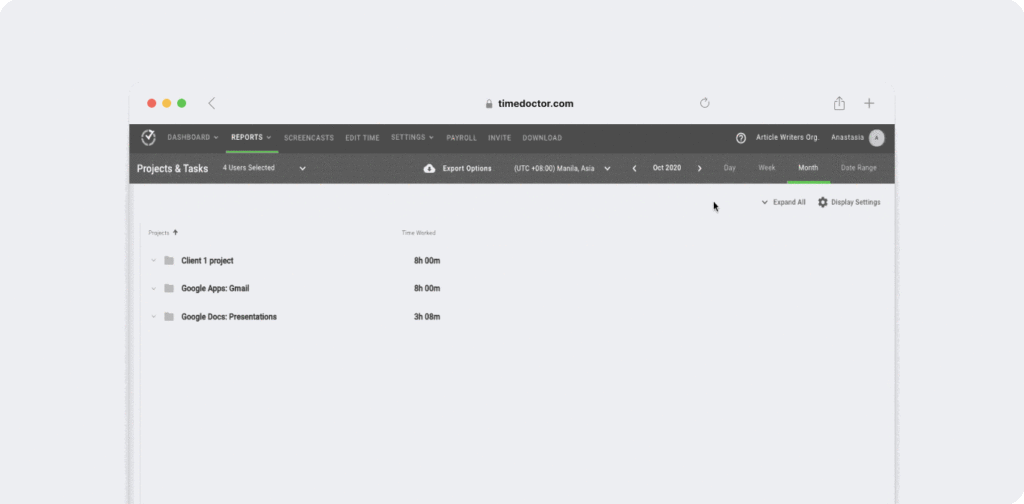
8. Attendance report
View presence against expected schedules to monitor attendance and spot trends that may affect planning and service levels.
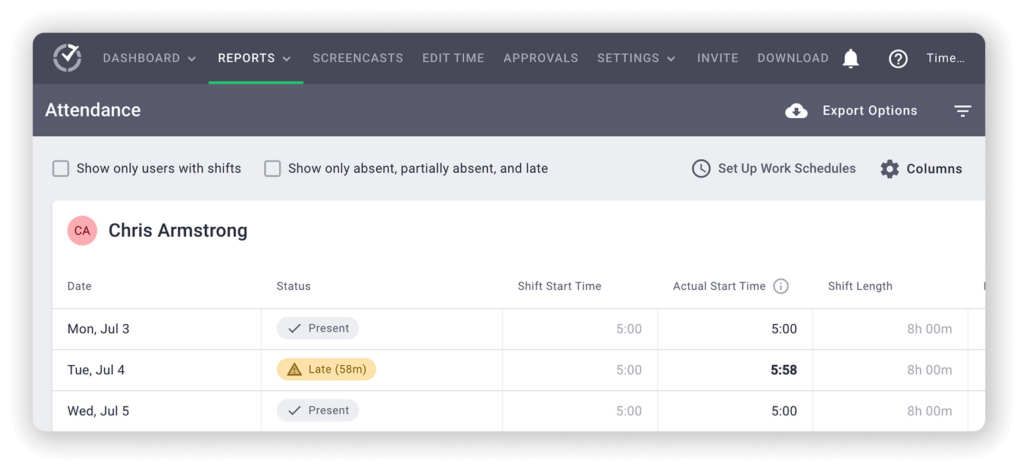
Most reports export to CSV or PDF, so you can share results, build productivity analytics, and streamline reviews with stakeholders.
6. Payroll invoicing and integrations
Paying your team and billing clients should feel straightforward.
You want activity tracking and time data to flow smoothly into payroll and client billing, with minimal manual work required.
That’s why these platforms connect tracked hours to pay rates and billable hours, add simple approvals to prevent errors, and sync with popular accounting and payment systems.
In the next section, we’ll compare how each tool handles pay runs, invoices, approvals, exports, and integrations, so you can choose the setup that best fits your workflow.
Hubstaff approach
Hubstaff offers payroll and invoicing features that connect tracked hours to pay runs and client billing, with approvals and exports that fit your process.
Here’s what you should keep in mind:
- Payroll options: You can run automatic or manual payroll from Hubstaff using connected providers. Supported options include PayPal, Wise, Payoneer, Bitwage, Gusto, and Deel.
- Invoicing: Hubstaff’s invoicing feature allows you to create and send invoices, and you can either automatically or manually add line items based on tracked time.
- Timesheets and approvals: You can require timesheet approvals to ensure hours are reviewed before payroll is processed, helping to keep records consistent.
- Accounting integration: Hubstaff integrates with QuickBooks Online, allowing you to automatically export time to your accounting system.

Time Doctor approach
Time Doctor connects tracked work to payroll and client billing in a way that’s clear, controlled, and easy to review. You keep approvals and access in your hands, while the platform turns timesheets and project data into payroll-ready and invoice-ready outputs..
With Time Doctor’s payroll feature, you can:
- Create reviewable timesheets from tracked hours and use approvals to keep entries consistent for payroll and client invoicing
- Map work to projects and tasks so hours roll up cleanly for project and billing analysis, supporting clearer costs and allocations.
- Export or integrate time data with your existing HR, finance, or accounting systems, reducing manual reporting and re-entry
- Maintain a digital trail with privacy controls (e.g., role-based access and screenshot blurring) to support compliance and audit readiness
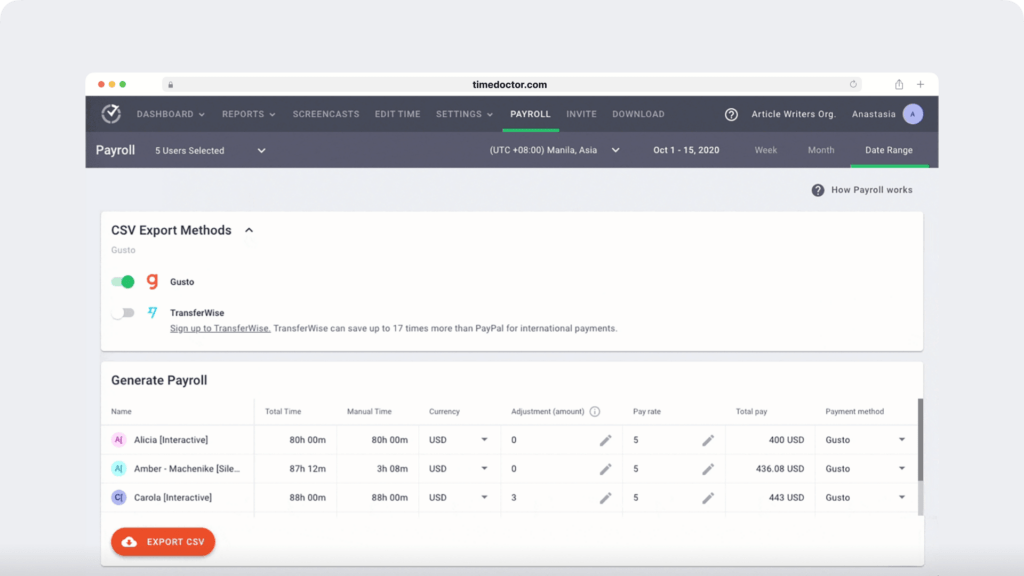
7. Pricing and plans
So, how much will these tools cost?
Can you still run a profitable business managing a remote team?
In this section, we’ll outline how each platform structures its plans and what to consider as you estimate total cost and value.
Hubstaff pricing plans
There are four different plans that Hubstaff provides to all its users:
- Starter: $4.99 per seat/month with a 2-seat minimum when billed annually. Includes core time tracking and productivity tools for small teams.
- Grow: $7.50 per seat/month with a 2-seat minimum when billed annually. Adds advanced tools, reporting, and one integration.
- Team: $10 per seat/month with a 2-seat minimum when billed annually. Includes payments, scheduling, and unlimited integrations.
- Enterprise: $25 per seat/month when billed annually. Includes custom setup, account provisioning, and dedicated support.
Hubstaff also offers a 14-day free trial on all paid plans and you can start without entering a credit card, making it easy to explore before you commit.
Hubstaff also offers a 14-day free trial on all paid plans.
Time Doctor pricing plans
Time Doctor provides 3 plans (billed yearly):
- Basic Plan — $6.70 per user/month .This covers the essentials for tracking work and tasks with screenshots, timelines, and online or offline capture.
- Standard — $11.70 per user/month. This includes team operations and reporting, such as schedules, attendance, approvals, web and app usage insights, productivity ratings, balance metrics, notifications, and integrations.
- Premium — $16.70 per user/month. It will layer on advanced analytics and admin controls such as Benchmarks AI, unusual activity insights, video screen recording, executive reporting, provisioning, historical data, API, SSO, and client login.
Time Doctor offers a 14-day free trial that doesn’t require a credit card, so you can test its full feature set before subscribing.
8. Ease of setup and user experience
You want a tool that your team can start using quickly, with a clean interface and minimal training requirements.
In this section, we compare Hubstaff and Time Doctor in terms of installation, onboarding, navigation, and admin controls, so you can see how each one fits into your rollout and day-to-day work.
Hubstaff approach
The setup of Hubstaff is straightforward.
- You send email invitations from your Hubstaff dashboard, and your team members join by accepting the invitation.
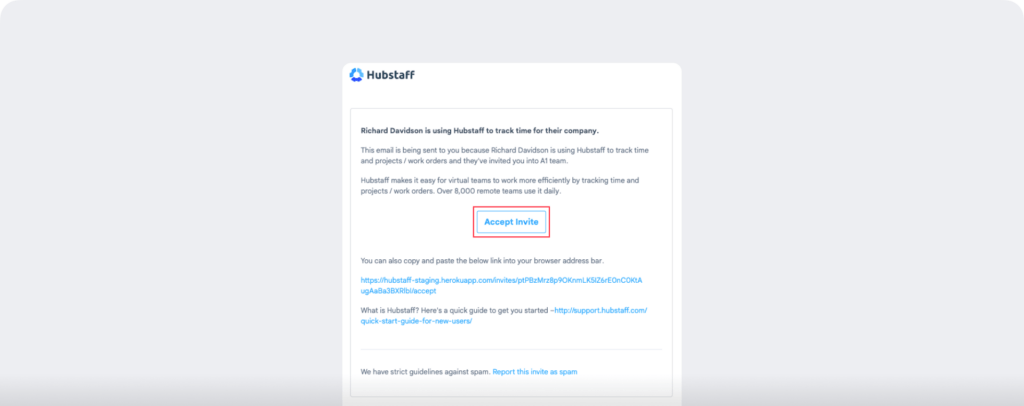
Direct your team to install the desktop app on Windows, macOS, or Linux. You can also allow the iOS/Android mobile app or the Chrome extension, depending on your policy.
- You assign projects and tasks. Team members select the right task and start the timer. Tracked hours appear in your dashboard and timesheets for review and approval.
- On desktop, you can enable options such as screenshots and app/URL usage tracking when your policy allows it.
- On mobile, the experience focuses on time tracking and location features for field teams.
Enter a few more details like your name and email address and confirm this email.
You’ll need to download the desktop client by clicking on your avatar. It can be found on the bottom left-hand side of your web dashboard. See below:

Time Doctor approach
Getting started is simple and fast.
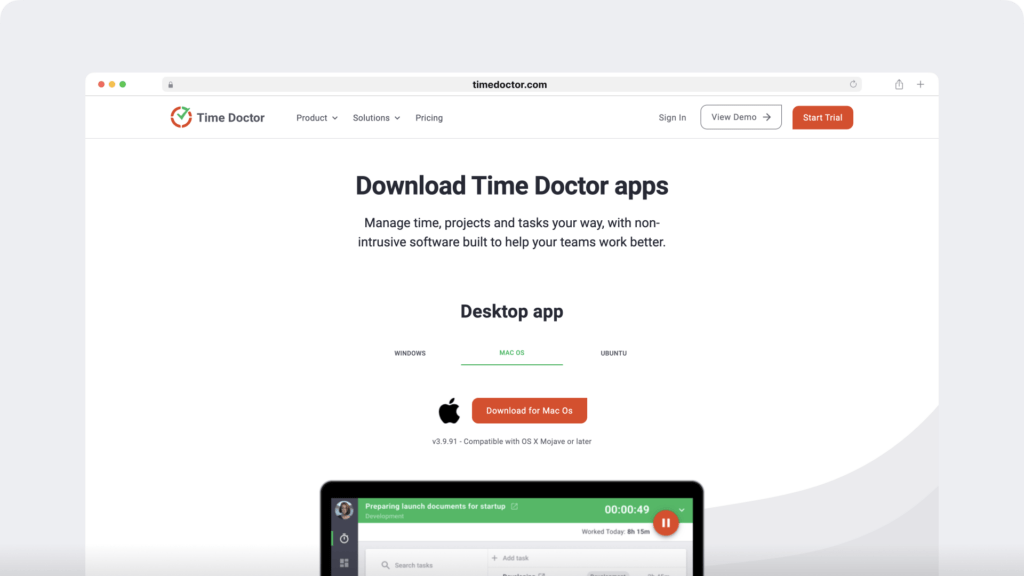
- Send email invites from the admin console, set roles, and choose the policies you want to use.
- Your team can use the desktop app on Windows, macOS, or Linux, the browser extension (Chrome or Firefox), or the iOS/Android mobile apps.
- Team members sign in, select approved projects or tasks, and use the start/stop timer to track their progress. Hours are posted to your dashboard and timesheets for review and approval.
- Turn screenshots on or off, apply blur, choose how detailed Web & App reporting should be, and set idle prompts, so the setup matches your policy.
- In-app tips and a help center make onboarding smooth, and support is available if any questions arise.
- This keeps rollout light for IT and gives you a clear, consistent user experience from day on
Key differences at a glance between Hubstaff and Time Doctor
| Feature | Hubstaff | Time Doctor |
| Time tracking | Timer-based tracking with manual time options | Interactive task timers with offline and manual options |
| Idle time alerts | Idle warnings with keep/discard choices | Configurable idle prompts and gentle focus nudges |
| Reporting | Operational reports (time, activity, apps/URLs, budgets, attendance) | Workforce analytics (timelines, activity signals, web/app usage, projects, attendance) |
| Integrations | 30+ integrations across project, accounting, payroll, CRM | 60+ integrations across payroll, CRM, HR, project tools |
| Privacy controls | Optional screenshots, blur, and permissions | Screenshots and screen recording with blur, role-based access, adjustable web/app detail |
| Best for | Field teams, contractors, and SMBs | Distributed or hybrid teams that want coaching insights without micromanagement |
Which tool fits your team best?
Match the platform to the work you manage daily.
Choose Hubstaff if you
- run field or job-site teams and need location-aware tracking with GPS tracking and job sites
- want straightforward time tracking on desktop and mobile for simple rollouts
- plan to review activity levels and, on desktop, enable screenshots plus app and URL tracking
- need scheduling and attendance and expect to connect payroll and invoicing to your accounting tools
Choose Time Doctor if you
- lead distributed, hybrid, or compliance-focused teams and want workforce analytics with Benchmarks AI for secure visibility and coaching insights
- need interactive task timers, timeline views, and configurable idle prompts, plus offline capture and controlled manual time to keep timesheets accurate
- want adjustable web and app usage detail that fits your privacy policy, along with optional screenshots or short screen recording with blur and role-based access
- plan to integrate approval-backed data with your HR, finance, and project tools to streamline payroll, billing, and reporting
Both platforms install quickly and integrate seamlessly with existing systems, allowing you to choose the one that best supports your priorities for visibility, privacy, and day-to-day operations.
Final thoughts
Both platforms can be the right choice, and the decision in Hubstaff vs Time Doctor really depends on how you want to manage and measure employee work to run smoothly.
If your day-to-day tasks involve straightforward employee time tracking for mobile or field work, Hubstaff can be a good fit and help keep everyone aligned.
But if your priority is turning work signals into outcomes, Time Doctor’s workforce analytics help you coach faster, protect focus without micromanagement, and keep a distributed workforce steady across remote, hybrid, and in-office settings.
Imagine what would change if you could see focus shifts a day earlier and turn that insight into better delivery, healthier productivity analytics, and more consistent attendance and payroll planning.
So find what’s best for your team.
Note: Details, features, and prices in this comparison are current as of October 7, 2025. Since software is periodically updated, please verify the latest information on each product’s website before making a decision.
Frequently asked questions(FAQs)
Define two or three outcomes upfront, such as cleaner timesheets, fewer handoff delays, or steadier focus time. Use Time Doctor’s role-based dashboards and clear audit trail to compare teams side by side without changing how they work.
Group teams by role and use standardized metrics, then review trends rather than raw totals. Time Doctor’s workforce analytics help you see effort and outcomes together, so coaching feels fair and specific.
Yes. Work-life balance signals and real-time visibility help you identify late nights, shortened breaks, or overload early, allowing you to rebalance your capacity before performance dips.
Leaders can scan high-level dashboards that surface what changed, where bottlenecks appear, and where momentum is building. That means faster, smarter decisions with less time in spreadsheets.
You can tune visibility levels, use screenshot blurring, enable 2FA, and assign role-based permissions. These controls protect people while ensuring that records are reliable for reviews and audits.
Pick one behavior to improve, such as reducing context switching before deadlines. Then track simple before-and-after indicators. Time Doctor’s distraction nudges, timelines, and activity signals make the impact visible without micromanagement.
Roll out by groups with consistent policies and lightweight onboarding. Intuitive UI and 24/7 support keep adoption smooth while your leaders get the insight they need to guide remote, hybrid, or in-office teams.
You can use Time Doctor’s benchmarks to compare like-for-like work. Set role-based targets and let workforce analytics highlight meaningful shifts in focus and output so coaching feels fair and actionable.

